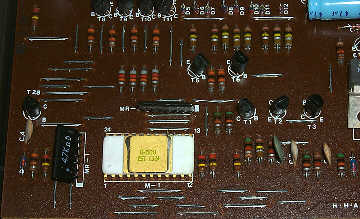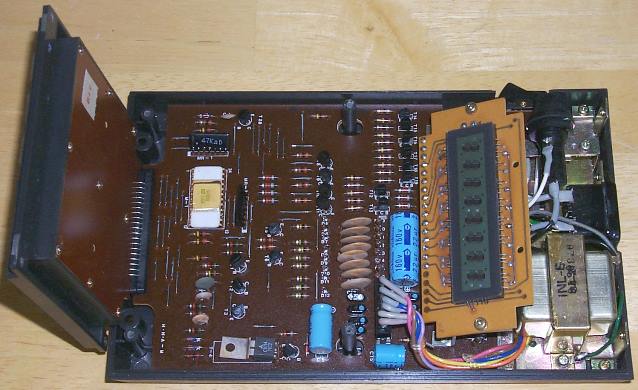

| +Home | Museum | Wanted | Specs | Previous | Next |
Royal Digital VIII-K Calculator
The Royal VIII-K is a great example of the early, low-cost calculators based on large-scale single-chip integrated circuit devices. The machine is functionally identical to another calculator in the museum, the Commodore US*1, of similar vintage. Both machines are based on the General Instrument C-500 single-chip calculator large-scale integrated circuit, and share their origins in the early part of 1973. The calculator was made by Royal Typewriter Company, which by that time had been acquired by Litton Industries, which made a point of acquiring a number of business machine companies in the late 1960's and early 1970's.
Given that both the VIII-K and the Commodore US*1 share the same calculator chip, it would stand that both machines operate identically. What that assumption holds true in most cases, there are differences based on the implementation of the support circuitry around the calculator chip. Both machines provide floating decimal, algebraic logic, the four basic math functions, and a constant that operates in all four functions.
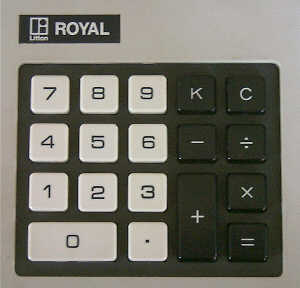
The Keyboard of the Royal VIII-K
The keyboard of the Royal VIII-K is a sealed unit that uses spring-type contacts. The keyboard assembly connects to the main circuit board via wire jumper wires. The keyboard uses nice large key caps with molded in nomenclature.
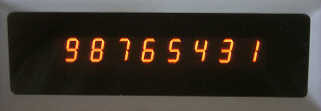
Display in Operation
The Royal VIII-K uses a very unusual planar gas-discharge display. The display module consists of a glass sandwich with metal plates inside that outline the shape of the segments. A great many wires come out the top and bottom edges of the display module, which appear to bring out each segment and a common line for each digit. The module is soldered to a circuit board that connects all of the segment lines together for display multiplexing, and brings out each of the common digit lines for scanning as part of the multiplexing operation. The display circuit board connects to the main circuit board by a series of hand-soldered wire jumpers. The display has a pleasing look to it, with the segments appearing to be rounded off rather than having sharp edges, making the digits look more continuous than the rather blocky conventional seven-segment displays.
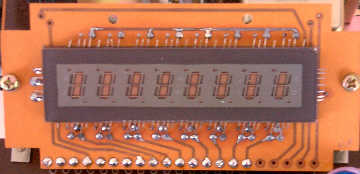
Detail of the Display Module
The display is driven by discrete transistor circuitry. The VIII-K does not provide any form of zero suppression, which is not uncommon for calculators of this price-range. The display uses the standard seven-segment digit arrangement, with a right-hand decimal point included with each digit. The display module also includes a 'tick' at the upper-left of each digit, however, this feature is not used.
The General Instrument C-500 LSI and Supporting Circuitry The VIII-K seems to be a bit faster
than the US*1, giving virtually instant results to any calculation. Given
that both machines share the same IC, all one can conclude is that
the VIII-K provides a somewhat faster main clock frequency to the calculator
chip than the frequency used on the US*1.
The Royal VIII-K provides a constant function on all four math
functions. The [K] key is used to set the constant and the type of operation
to be performed. For example, constant multiplication by two would be
done by pressing [2], then [X], followed by the [K] key. Once constant
operation is set, constant mode is cleared by pressing the [C] key,
which clears constant mode.
Overview of the of the Royal VIII-K with Upper Cabinet Removed The Royal VIII-K uses a simple linear
power supply, with a small transformer stepping down the line voltage to
lower voltage AC-power, which is rectified, smoothed, and regulated by
circuitry on the main circuit board. The calculator uses a removable
standard NEMA-style instrument power cord. An unusual feature
of the VIII-K is that the power supply of the VIII-K is fuse-protected,
using a standard fuse holder located inside the case of the calculator.
Most calculators in this cost category have soldered-in fuses, requiring
de-soldering of a blown fuse, and soldering
in a replacement should the fuse fail. Fuse replacement is
comparatively easy with the VIII-K, with the fuse
holder cap is simply unscrewed, the bad fuse removed, a replacement fuse
installed, and the fuse holder cap screwed back on. In order to access
the fuse holder, though, the top half of the cabinet of the calculator
must be removed to gain access to the fuse holder. The cabinet requires
the removal of four screws from the underside of the calculator that hold
the halves of the cabinet together.
Detailed View of Insides of the Royal VIII-K with Keyboard Tilted Away
Like the Commodore US*1, the Royal VIII-K does not provide any
form of overflow or error detection. Results in excess of the capacity
of the machine are simply discarded. The calculator does keep track of
decimal point locations up to an additional eight digits beyond the end of
the display. For example, performing 99999999 X 99999999 results in
"99999998", with no decimal point lit. Following this calculation with a
division by 10000000 results in "999999998." (note decimal point).
Numeric input in excess of eight digits is ignored.
The VIII-K also exhibits the same unusual counting behavior as the
Commodore US*1 when commanded to divide by zero, clearly being an artifact
of the General Instrument C-500 calculator chip. Pressing the [C]
key will clear the confusion, returning the calculator to normal operation.
The C-500 calculator chip in the Royal VIII-K is quite remarkable, with the
chip being a tiny programmable computer programmed to behave as a calculator.
The story of the development of this "computer on a chip" calculator chip is
detailed in the Old Calculator Museum exhibit on the
Commodore US*1.
